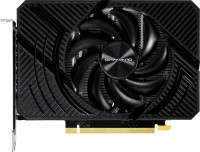Graphics Cards Gainward series Phoenix
prices on 1 modelGainward Phoenix
The Phoenix line from Gainward (note: a subsidiary brand of Palit) includes exclusively reproducible modifications of GeForce video cards with an above-average level. They are equipped with high-performance power converters and efficient cooling systems, have a small factory overclock and ARGB backlighting with an automatic synchronization system. Perhaps the main feature of the series is the desire to make everything one level better than that of competitors.
 |
For example, the RTX 3070 and 4070 Phoenix models use the same circuit board, power system, and coolers with a heatsink that are more commonly seen in the higher-end RTX 3080/4090. The cooling systems are made according to the same patterns as those of distant relatives from the Palit Jetstream family: on both sides the printed circuit board is covered by a massive copper plate and a thick heatsink with a direct contact area, heat pipes pierce the heatsink, 3 Cyclon coolers with asymmetric fins cover the entire structure from above and double ball bearings, and thermal modules are adapted to the requirements of Ada Lovelace chips. The printed circuit board is usually 30 to 35 cm long, and the cards themselves take up about three motherboard slots. Miniature models with two active turntables are not considered by the manufacturer in principle.
The Gainward Phoenix lineup is dominated by NVIDIA GPUs of the latest generations of mid- and top-end: models of the 3000 series Ampere (8 nm) and more powerful and modern video cards of the 4000 series with Ada Lovelace chips (5 nm). Both generations feature additional cores for hardware ray tracing and artificial DLSS image scaling. The difference is that members of the Ada Lovelace family are equipped with more modern versions of tensor cores with an integrated Optical Flow engine that perform better and more efficiently than their predecessors. In addition to the standard modifications, the Phoenix series also produces slightly more advanced versions with the GS prefix (note: Golden Sample) in which the core is usually overclocked by 100-120 MHz above the nominal value.



